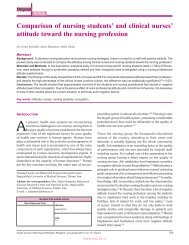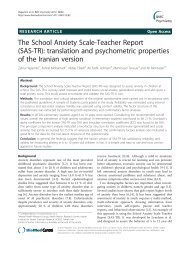Gastrointestinal Nursing.pdf
Gastrointestinal Nursing.pdf
Gastrointestinal Nursing.pdf
You also want an ePaper? Increase the reach of your titles
YUMPU automatically turns print PDFs into web optimized ePapers that Google loves.
The Large Intestine 85Inflammatory bowel diseaseIntroductionCrohn’s disease and ulcerative colitis are idiopathic chronic diseases. Althoughthey are generally recognised as distinct clinical syndromes they are veryclosely related illnesses and are commonly grouped together under theterm inflammatory bowel disease (IBD). In this section nursing care will beexamined without distinction between Crohn’s disease and ulcerative colitis.Current best practice in IBD has been published by the BSG (1996).The prevalence of Crohn’s disease varies between geographical locations. Itaffects 5 in 100 000 of the population in Northern Europe, the United States ofAmerica and Australia but appears less common in other areas of the world. Itis likely that 20 000–30 000 individuals are affected in the UK (www.bsg.org.ukaccessed 8 May 2000).Crohn’s disease occurs more frequently among Caucasians than those ofAsian and African origins. The incidence of Crohn’s disease in British Asiansis higher than in natives from the Indian sub-continent. Similarly, among Afro-Caribbeans the incidence of Crohn’s disease is greater in black British WestIndians than in native Africans. Crohn’s disease is three to eight times morecommon among Jews than non-Jews and is more common among whites thannon-whites.These findings, however, must be interpreted with caution as access to healthcare and diagnostic facilities vary between regions and may vary for populationsin the same region. Nonetheless they do suggest that a modernised industrialisedenvironment may contain aetiological factors and co-factors for IBD.The frequency with which Crohn’s disease has been diagnosed rose steadilyfrom the 1950s for about 20 years. This may have been due to increased diagnosticawareness as well as a true increase in disease frequency; the diseasefrequency has stabilised in the last 20 years.Crohn’s disease can present at any age although it most commonly developsbetween 15 and 30 years of age. It occurs equally commonly in men andwomen and, at least in the UK, is unaffected by social class.Ulcerative colitis affects 10 in 100 000 of the general population and is nearlytwice as common as Crohn’s disease. There are no associations with race,gender and social class. The median age of incidence lies between 15 and 30years with a second peak between 55 and 70 years, although no age is exempt(www.bsg.org.uk accessed 8 May 2004).Predisposing factorsThere are many suggested predisposing factors related to the development ofIBD. The tendency for IBD to occur in populations living in Northern Europeand North America has inevitably suggested a causal link with dietary habits,particularly with dietary fibre and sugar consumption.















